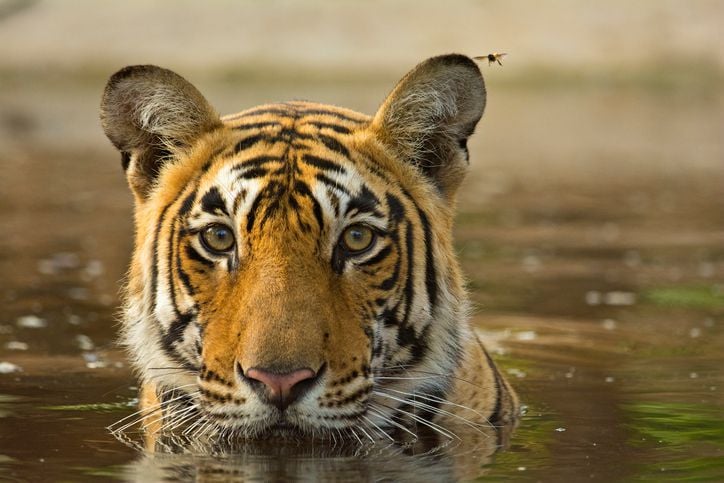The first national park in India was only established in 1936, but the country has since demonstrated its commitment to protecting areas of important biodiversity by founding a further 102. Expect to see Royal Bengal tigers, snow leopards and picturesque mountains as we travel across this vast country to introduce you to the best Indian national parks.
Indian national parks in the north of the country:
Jim Corbett National Park, Uttarakhand
India’s first national park, Jim Corbett is a paradise inhabited by over 200 Bengal tigers, 300 wild elephants, plus populations of gharial crocodiles, sambar deer, king cobra and langur monkeys.
Founded to protect the endangered Bengal tiger, the park has strict limits on visitor numbers. Only 60 vehicles are allowed inside the park at any one time.
When to visit: As a very popular destination for tourists, it’s best to book a safari a couple of days in advance to ensure you will be able to enter the park. Visit between November and March for excellent weather or March through May for the best chances of seeing the park’s rare wildlife.
Nanda Devi National Park, Uttarakhand
The rugged wilderness of Nanda Devi National Park is the true magnet that draws adventurous travelers in their droves. Located in the West Himalayas, the park is a UNESCO World Heritage Site listed thanks to its unique geography; here, the 25,64 ft. (7,817m) summit of India’s second highest peak, Nanda Devi plunges into the profound depths of the Rishi Ganga gorge, making much of the park inaccessible.
 But it is the remoteness of the Nanda Devi National Park that has enabled it to maintain its rich diversity of flora and fauna. Although it’s unlikely you’ll spy a threatened snow leopard padding through the wilderness, you’ve got a chance of spotting bharal (Himalayan mountain sheep) and some of the over 80 species of birds that have been identified in the area.
But it is the remoteness of the Nanda Devi National Park that has enabled it to maintain its rich diversity of flora and fauna. Although it’s unlikely you’ll spy a threatened snow leopard padding through the wilderness, you’ve got a chance of spotting bharal (Himalayan mountain sheep) and some of the over 80 species of birds that have been identified in the area.
When to visit: Only two small groups of visitors are permitted into the national park each day so a reservation with a local tour agency well in advance is essential to avoid disappointment. Visit between April and June to avoid winter snow and summer rainfall.
Desert National Park, Rajasthan
In the west of the country, close to the border with Pakistan, lies Desert National Park. The dominant ecosystem is semi-arid desert, but the park still manages to support a huge diversity of flora and fauna, particularly in the numerous bird species that survive despite the harsh conditions.
The critically endangered Great Indian bustard is one of the highlights of this park, while short-toed eagles, laggar falcons and kestrels are the most common birds. Animal and plant fossils believed to date back 150 million years and a range of ancient dinosaur fossils have been unearthed.
When to visit: Avoid the monsoon rains by visiting between October and March.
Indian national parks in the center of the country:
Bandhavgarh National Park, Madhya Pradesh
Another of the most interesting Indian national parks for those hoping to see Royal Bengal tigers is Bandhavgarh National Park. With its population of 48 of these striped, majestic creatures, it is believed to have the highest concentration of this species of tiger in all of India.
 Less frequently seen, but still present, are a small population of around 40 leopards and sloth bears, the latter of which is a reclusive, nocturnal species native to the forests of India, Nepal and Sri Lanka. Several species of deer, langur monkeys and Indian bison complete the wildlife.
Less frequently seen, but still present, are a small population of around 40 leopards and sloth bears, the latter of which is a reclusive, nocturnal species native to the forests of India, Nepal and Sri Lanka. Several species of deer, langur monkeys and Indian bison complete the wildlife.
When to visit: The park is closed July through October and it’s recommended to visit between February and June.
Keoladeo Ghana National Park, Rajasthan
Located only a short distance from Agra on the golden triangle circuit, Keoladeo Ghana National Park is one of the best places for bird watching in the country. Over 230 species are found within the park and it is an important wintering area for birds from across Afghanistan, China, Siberia and Turkmenistan, including the Siberian Crane and the Greater Spotted eagle.
Get up early as boat trips at dawn are your best chance of spotting birds in this UNESCO World Heritage site.
When to visit: November through March, when thousands of migratory birds descend upon the park.
No comments yet
There are no comments on this post yet.





Leave a comment